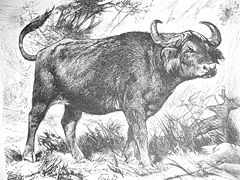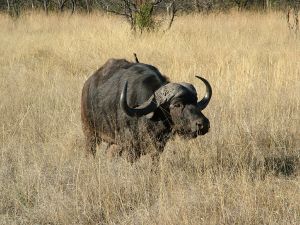Buffalo
| African Buffalo | ||||||||||||||||||||||
|---|---|---|---|---|---|---|---|---|---|---|---|---|---|---|---|---|---|---|---|---|---|---|
 19th century drawing
| ||||||||||||||||||||||
| Scientific classification | ||||||||||||||||||||||
| ||||||||||||||||||||||
| Syncerus caffer (Sparrman, 1779) | ||||||||||||||||||||||
|
S. c. caffer |
The African Buffalo or Cape Buffalo (Syncerus caffer) is a bovid from the family of the Bovidae. It is up to 1.7 meters high, 3 meters long, and can reach a weight of 1000 kilograms. On average, an adult male stands about 1.5 m high at the shoulder and weighs 680 kg, while a female is 10 - 15 cm shorter and weighs between 500 - 600 kg.
The Cape Buffalo is not closely related to the Asian Water Buffalo, but its ancestry remains unclear. It is a very powerful creature, demanding respect from even a pride of lions when paths cross. Other than humans, they have few natural predators and are capable of defending themselves against (and sometimes killing) lions. Lions do kill and eat buffalo occasionally, but it typically takes multiple lions to bring down a single adult buffalo; fewer when it is injured or very old. The leopard and spotted hyena are a threat only to newborn calves. Crossbreeding with domestic cattle has had only limited success, and the African Buffalo remains a wild animal.
Known as one of the "big five" in Africa, the Cape Buffalo can be a volatile and formidable beast, goring, trampling and killing several people a year. It is reputedly the most dangerous game animal, with the possible exception of the hippopotamus.
Cape Buffalo occur from open savannah to thickly wooded country, and wallow when the opportunity presents itself. They are found in Ethiopia, Somalia, Zambia, Zimbabwe, Namibia, Botswana, Mozambique, South Africa, Kenya and Tanzania.
The main herd consists of both sexes and all ages, though bachelor groups are also found. A male is recognizable by the thickness of his horns, and is called the "Boss." Bulls mature at eight years of age. Cows first calve at five years of age, after a gestation period of 11.5 months. Older bulls forced out of herds are commonly found in bachelor groups.
ReferencesISBN links support NWE through referral fees
- Antelope Specialist Group 1996. [1]. 2006 IUCN Red List of Threatened Species., World Conservation Union. Retrieved on 11 May 2006.
External links
- http://www.nature-wildlife.com/buftxt.htm
- Cape Buffalo (Syncerus caffer caffer) facts and photography - Wild Animals Online encyclopedia
Credits
New World Encyclopedia writers and editors rewrote and completed the Wikipedia article in accordance with New World Encyclopedia standards. This article abides by terms of the Creative Commons CC-by-sa 3.0 License (CC-by-sa), which may be used and disseminated with proper attribution. Credit is due under the terms of this license that can reference both the New World Encyclopedia contributors and the selfless volunteer contributors of the Wikimedia Foundation. To cite this article click here for a list of acceptable citing formats.The history of earlier contributions by wikipedians is accessible to researchers here:
The history of this article since it was imported to New World Encyclopedia:
Note: Some restrictions may apply to use of individual images which are separately licensed.

